When we swapped our old batter for the Evans EMAD2 Clear 22″, it felt less like changing a part and more like giving the bass drum a new personality. The headline feature – an externally mounted, adjustable damping system with two removable foam rings – is the kind of practical, hands-on innovation drummers actually use. Over a few rehearsal sessions and a couple of tracking runs, we found the EMAD2 lets you dial attack, focus and sustain with minimal fuss: thinner foam for punch and clarity, wider foam for thump and low-end warmth.
Beyond the damping, the construction stood out.The two-ply film (7mil outer, 10mil inner) felt robust under stick and pedal, and the Level 360 collar made seating and tuning noticeably quicker and more consistent than some older heads we’ve wrestled with. The result was a wider, more usable tonal range that translated well whether we wanted a tight, cutting kick or a round, room-filling boom.
We tested it across several genres and setups – from tight rock grooves to looser country feels – and the EMAD2’s adjustability proved genuinely versatile. It’s clearly aimed at working drummers who need a dependable, tweakable head that can go from stage to studio without a lot of compromise.In the rest of this review we’ll break down how it performs in detail: tone, attack, tuning, durability, and whether those two foam rings are really enough to cover every situation.
Our First Impressions of the Evans EMAD Clear Bass drum Head and What Sets It Apart
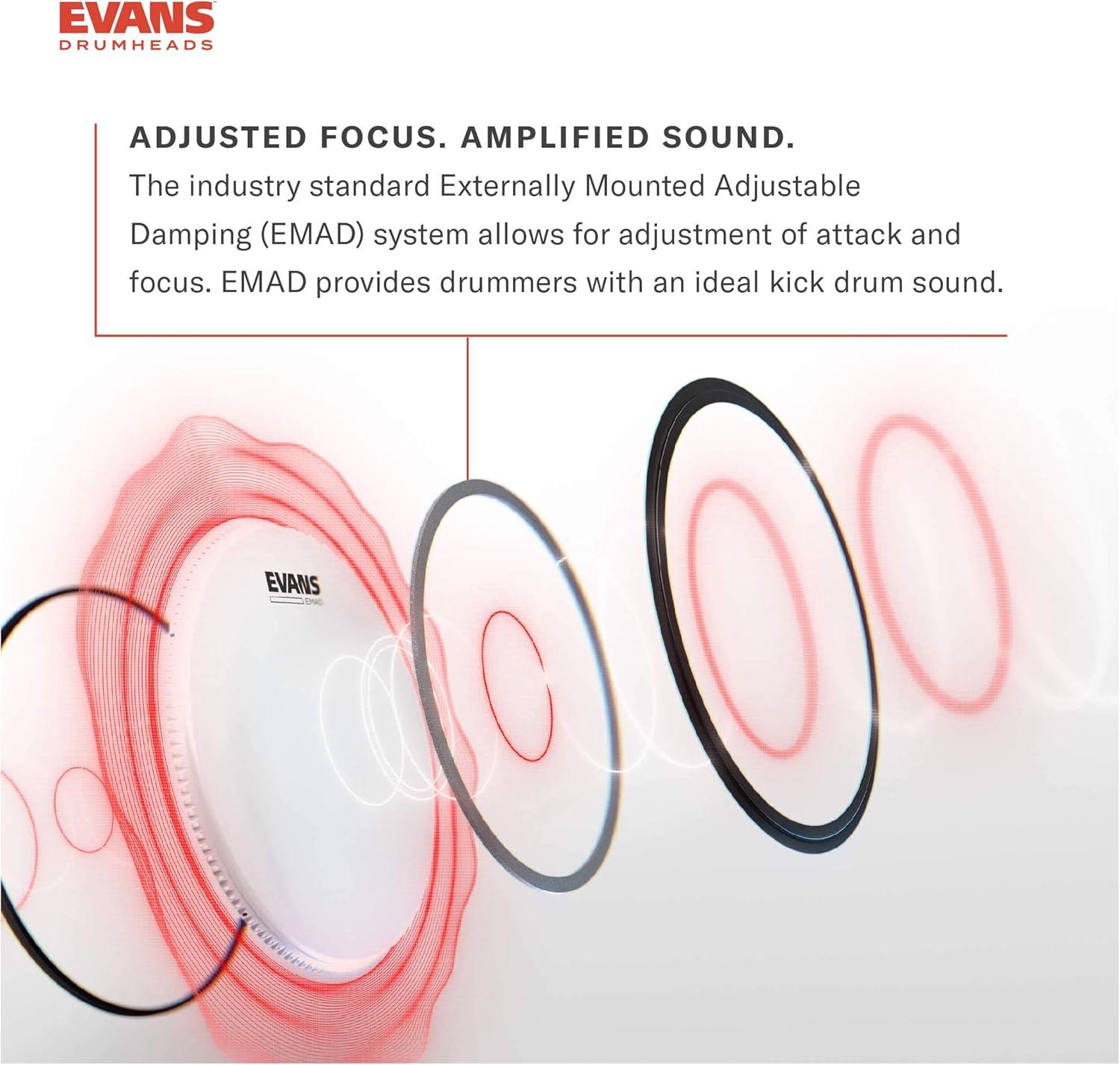
When we first mounted the head we noticed a clean, controlled response right away – largely thanks to the externally mounted adjustable damping and the new Level 360 collar that seats the head so it tunes quickly and evenly. Swapping between the two removable foam rings unlocked distinctly different personalities: one gave us tight punch and focus without killing sustain, the other emphasized low-end thump and more pronounced attack. The construction also stood out: a thin 7mil outer ply over a sturdier 10mil inner ply felt durable yet resonant, and the whole setup translates well across rock, blues, country and heavier styles. Our quick takeaways:
- Quick tuning thanks to the level 360 collar
- Two damping options for distinct tonal shapes
- Balanced durability with the dual-ply film
We tested both foam rings in a 22″ setup and the differences were immediate and usable in a live mix – swapping rings is simple and gives you practical control over attack and focus. The head family spans 18″-26″ sizes and carries the assurance of being made in the USA by a company with over six decades of drumhead advancement, which shows in the fit-and-finish and consistency. Below is a quick comparison we kept handy while dialing tones in the studio:
| Ring | character | Best For |
|---|---|---|
| Thinner | Punchy, focused | Clear, articulate grooves |
| Wider | Deep, booming | Big ballads & heavy styles |
How the Externally Mounted Adjustable Damping System and Foam Rings Shape Our Sound
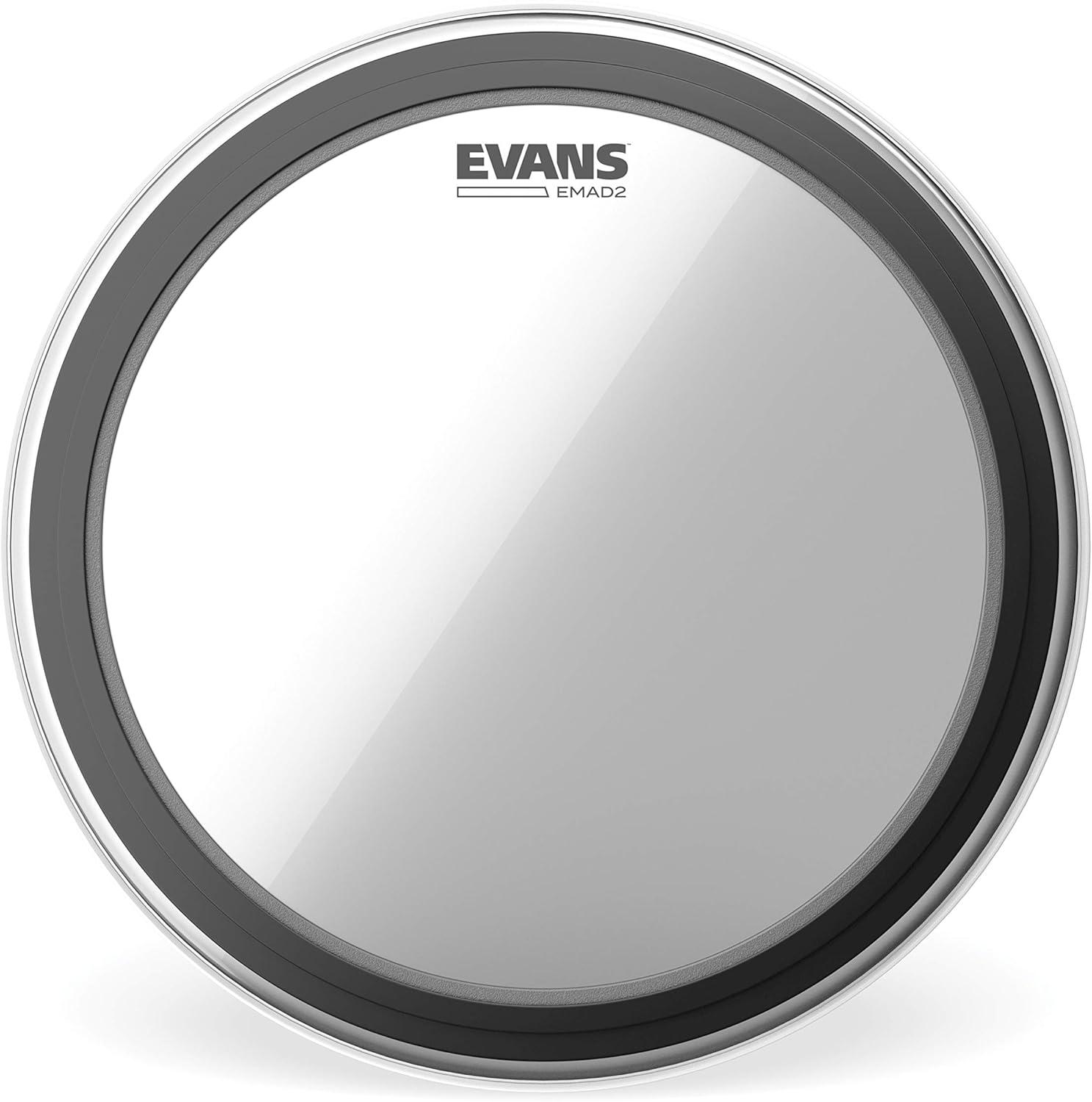
We instantly noticed how the externally mounted damping system puts tonal control in our hands: the adjustable collar and two removable foam rings let us dial attack and focus on the fly. With the thinner foam ring we get a pronounced punch and tight focus while still keeping a pleasing amount of resonance; swap to the wider foam ring and the low end blooms, delivering maximum weight and a stronger attack that fills the room. The 22″ head’s dual-ply construction (7mil outer, 10mil inner) gives this setup durability and a consistent response, while Level 360 technology helps the head seat itself properly so tuning is faster and the tonal range expands – a combination that makes our kick sound studio-ready without endless mic trickery.
In practice we used the rings like presets during sessions: quick change for a punchy backbeat, wider ring when we needed more warmth and push. Below we summarized the tonal shifts so it’s easy to hear what each choice does for our kit.
- Punch & Focus – thinner ring; cuts through dense mixes
- Low-End & Power – wider ring; adds weight and presence
- Balanced Resonance – no ring or light use; more sustain
| Foam Ring | Effect | Best For |
|---|---|---|
| Thinner | punchy, focused | Rock, pop |
| Wider | Fuller low end, strong attack | Metal, country, studio |
Hear the Difference - Buy Now
Tonal Details, Setup Tips and Our Recommended Uses Across Genres

We love how the Level 360 collar and ply construction translate into a head that sits and tunes predictably, giving us a wider tonal range right out of the box. The externally mounted damping system is the game-changer: swapping between the thinner and wider foam rings lets us dial attack, focus and low-end weight without resorting to tape or pillows. Setup-wise we keep a few simple rules in mind to get consistent results:
- Seat first: let the collar settle into the hoop so the head beds evenly before you tune.
- Tune gradually: start low,bring all lugs up in small increments and tap around the hoop to even out tension.
- Choose your ring: use the thinner ring for punch and clarity, the wider ring when we want maximum low-end and attack.
- Match your beater: felt for warmth and roundness, plastic or wood for added click and presence.
The 7mil outer and 10mil inner plies feel durable yet responsive, so we can push volume in rehearsal or settle into a studio-friendly tone with just a couple of turns on the lugs.
Because the head responds so cleanly to simple damping changes, we recommend settings by genre to get a head start on tone:
| Foam Ring | Character | Best For |
|---|---|---|
| Thinner Ring | Punchy, focused, retains resonance | Rock, Blues, country |
| wider ring | Full low-end, strong attack | Metal, Heavy Rock, Studio Low-End |
We find the head’s versatility makes it a reliable choice across styles – swap rings, tweak a few lug turns and you’re ready for anything from intimate acoustic gigs to high-energy stage shows. Ready to try it on your kit? Grab it on Amazon
Pros & Cons

We put the EMAD2 22″ through its paces and boiled our impressions down to the essentials. Below you’ll find what won us over and what gave us pause - a quick, honest snapshot to help decide if this head fits our kit and playing style.
Pros
- Flexible damping on demand: The externally mounted EMAD system and two removable foam rings let us dial attack and focus quickly – from tight punch to fuller low end.
- Punch without killing resonance: The thinner foam ring gives a sharp, focused beater sound while keeping the drum alive.
- Big low-end option: The wider ring fattens the bottom end and increases attack for more presence in mix-heavy settings.
- Level 360 technology: The collar seats easily, making tuning faster and giving a wider, more usable tonal range – studio-ready sooner than some competitors.
- Built for durability: The 7mil outer ply and 10mil inner ply offer toughness that stands up to heavy hitters and frequent gigging.
- Genre-agnostic: From rock to country to metal, the EMAD2 adapts well – a true working drummer’s tool.
- Made in the USA: Consistent quality and attention to detail are noticeable in the fit and finish.
Cons
- Only two damping presets: The removable rings are effective, but they provide discrete choices rather than an infinite continuum of tone shaping.
- Less open, vintage bloom: Players chasing a very open, cathedral-like bass sound may find the EMAD2 a bit too controlled without the ring in place.
- Visible wear on clear head: The clear film and external hardware show beater marks and scuffs more readily than coated heads.
- Small parts to keep track of: The foam rings are removable and easy to misplace if we’re not careful on the road.
- Price vs basic heads: It’s costlier than entry-level single-ply heads – you’re paying for control and durability.
| Damping Setting | What We Heard |
|---|---|
| Thinner Foam Ring | punchy, focused attack; retains resonance |
| Wider Foam ring | Deeper low end and sharper beater presence |
| No Ring | Maximum open tone and sustain; less focus |
We appreciate how the EMAD2 hands control back to the player – it’s especially rewarding for drummers who gig and record. The trade-offs are deliberate: you gain focus,durability and tuning ease at the expense of a little vintage openness and the hassle of managing small parts. for us, that balance leans toward a yes if we want consistent punch and a ready-for-mix bass drum.
Q&A
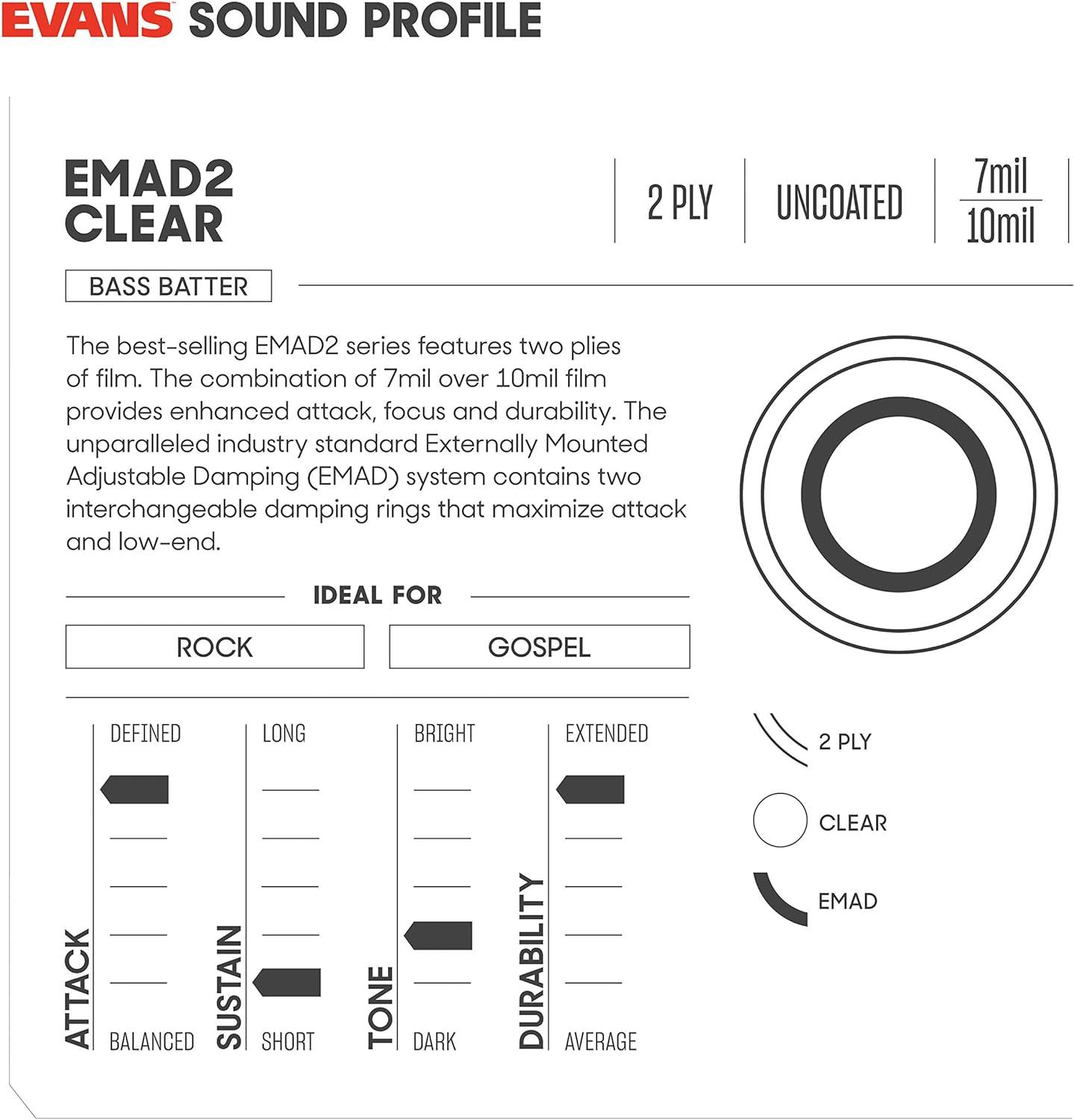
Q: What makes the EMAD2 22″ different from other bass drum heads?
A: For us the standout is the externally mounted EMAD system combined with Level 360 seating. That gives a rare mix of easily adjustable damping and smoother, more consistent tuning. The dual-ply (7mil outer / 10mil inner) construction adds durability while retaining a wide tonal range – more punch and control than a single-ply clear head,and easier to dial in than many heavy muffled options.
Q: How do the two foam damping rings actually affect the sound?
A: We treat the rings like tonal presets. the thinner ring tightens focus and preserves more resonance – grate when you want punch without killing the bloom.The wider ring emphasizes low end and attack, so the kick hits harder and reads better in a live mix. Removing the ring entirely gives the most open, resonant tone if you need that vintage boom.
Q: Is the EMAD2 easy to tune?
A: Yes.The Level 360 collar helps the head seat evenly, which removes a lot of the fiddly effort you usually spend chasing bad seating issues. Once seated, we found tuning to be stable across a usable range – low and fat, or tighter and clicky – with fewer weird overtones.
Q: Will it fit my 22″ hoop and shell?
A: It will fit any standard 22″ bass drum hoop. As always, we recommend checking your hoop radius and any pre-existing mic or port holes – the head itself is standard-sized and designed to work with typical 22″ hardware.
Q: How versatile is this head across genres?
A: Very versatile. We used it for rock, country, blues and heavier styles and it adapted well.For metal and rock, the wider ring or a slightly higher tuning gives the thump and attack you need. For rootsier music we preferred the thinner ring or no ring and lower tuning for more warmth. For very delicate jazz we’d lean toward option heads, but the EMAD2 can still work if tuned appropriately.
Q: How’s it for live sound and studio work?
A: The EMAD2 is studio-friendly – consistent,focused,and easy to mic – and it translates well on stage as you can tweak the damping quickly to suit the room. the clear surface gives a defined beater click, which many engineers appreciate. We also liked how the head sat in a mix without excessive ringing.
Q: Any durability concerns?
A: Not really.The 7mil + 10mil ply construction is robust and held up well to heavy playing in our tests. The externally mounted damping is removable but solid. As with any head, avoid extreme abuse and keep it tuned properly and it will last.
Q: How does it compare to a coated EMAD2 or other brands?
A: Compared to the coated EMAD2, the clear version is brighter with a crisper attack and more defined beater click; the coated one will be warmer and a touch more rounded. Versus competing brands, the EMAD2’s externally mounted damping and Level 360 seating give it an edge in quick adjustability and consistent tuning. If you want a one-head-does-many-jobs solution, EMAD2 is a strong contender.
Q: Any tuning tips or recommended settings?
A: we start with medium-low batter tension and slightly higher resonant tension, then pick the ring based on desired character (thin for punch/focus, wide for low end). for more click, tighten the batter a little; for more boom, loosen and use the wide ring or remove the ring and retune lower.Small adjustments go a long way – tune both hoops in small increments to keep the head seated evenly.
Q: Does the head affect beater choice or pedal feel?
A: The EMAD2 will emphasize what your beater provides. Felt beaters give warmer, rounder low end; wood or hybrid beaters with harder surfaces will increase the click and attack. We didn’t notice a change in pedal mechanics – it’s more about how the head responds dynamically to different beaters.
Q: Is it worth the price?
A: We think so. You’re paying for a durable,adaptable head with clever damping and improved seating that saves time and gets better results in both live and studio contexts. If you want a go-to 22″ head that handles many styles well,it’s a good value.
Q: Any final caveats?
A: Nothing major - just remember that no single head is perfect for every single application. If you prefer an extremely open, vintage boom or an ultra-muffled studio sound, you might pair the EMAD2 with other heads or external damping.But for most drummers looking for focus, punch and adaptability, this head covers a lot of ground.
Achieve New Heights

We’ve taken the EMAD2 22″ through rehearsal rooms and quick studio runs,and our takeaway is simple: this head gives us control. The externally mounted EMAD system and the two removable foam rings let us dial in punch or low-end thump without fighting resonance, while the Level 360 collar makes seating and tuning noticeably easier. Built with a 7mil outer ply and a 10mil inner ply, it feels durable and consistent – a true working drummer’s tool that adapts across rock, blues, country, metal and beyond. It’s not a magic wand that reinvents your kit’s voice, but it is a reliable, versatile choice when we want focused attack or more weight on demand.
If you want to try one for yourself, pick up the Evans EMAD2 22″ here: Buy the Evans EMAD2 22″ on Amazon

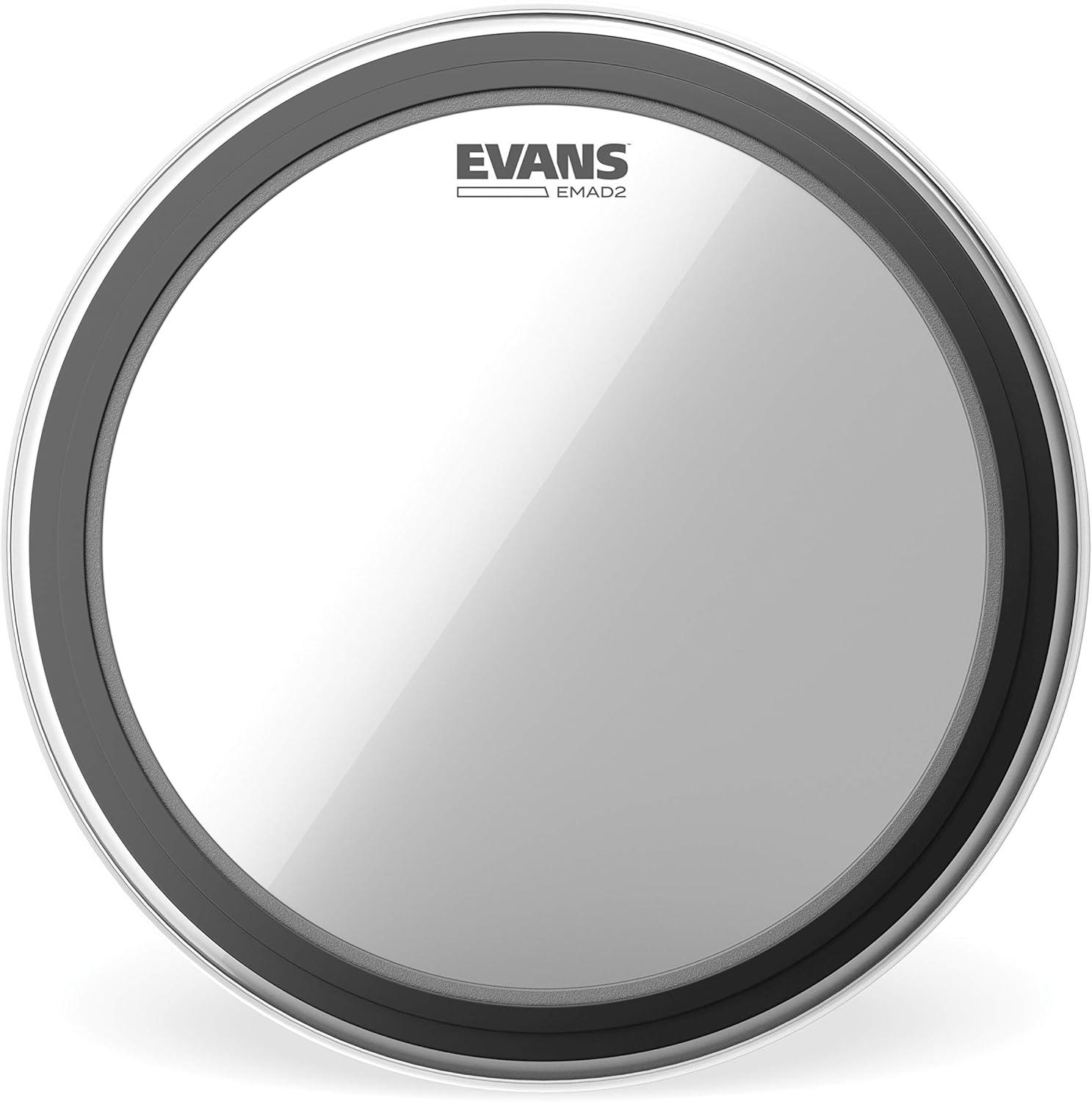
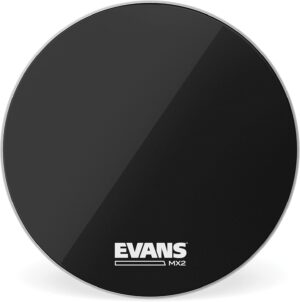
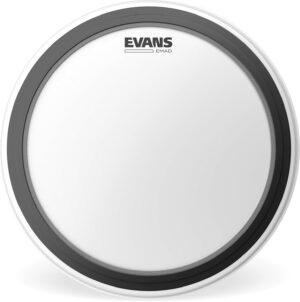
Reviews
There are no reviews yet.